| ICE-T |
![]()
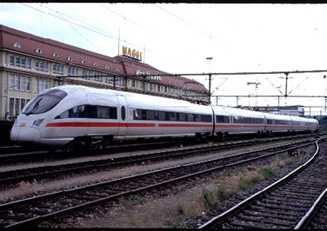 Class 415 in Singen (Photo) Masatoki Minami |
| In Germany, some high speed lines were built from the 1980s, and ICE
started its service in 1991. Although the construction of high speed lines
has a great effect on a speedup, the building cost is very expensive, So
it's impossible to construct them in local region. For a speedup of local
routes, the adoption of tilting train is effective. (In Europe some tilting
trains like ETR450 of FS, X2000 of SJ was already used in the early 1990s.
And DB used diesel tilting railcar, class 610) In 1993 and 1994, a investigation
was made to confirm how tilting train is effective economically. According
to it, tilting trains are effective especially in the mountain region of
the middle and south Germany. If using tilting trains, DB can shorten the
travel time of trains, reduce the number of trainsets and operation cost.
So DB decided to order tlting high speed trains. In 1994, Deutsche Bahn ordered 43 sets of tilting high speed train DWA (End cars), Duewag (Middle cars), Siemens (Electric equipment) and Fiat (tilting system). 11 sets consist of 5 cars (Class 415) and 32 sets consist of 7 cars (Class 411) . These electric railcars were called "ICT" (InterCity-Triebwagen). They are based on ICE-3, sothe traction is distributed in whole trains. ICT entered in service in May 30, 1999 between Stuttgart and Zürich. Then ICT was decided to be operated as "ICE", so ICT was called "ICE-T" instead of "ICT". Diesel sets of ICE-T (ICE-TD, class 605) is tested now. This new class will enterd in service in spring 2000. Electric ICE-T can be coupled with this diesel version and other ICE series except for ICE-1. The width of ICE-T is 2.85m, the length of end cars is 27.45m, the height 3.89m, and the length of middle cars is 25.9m, the height 3.84m. Each motor car has two 3-phase AC motor whose power output is 500kW. The maxium speed is 230 kph. The Fiat's tilting system is same as that used for ETR460"Pendolino" and ETR470"Cisalpino". In curves, ICE-T can run at 20% higher speed than normal trains. The exterior design is similar to that of ICE-3, but ICE-3 has shaper nose. |
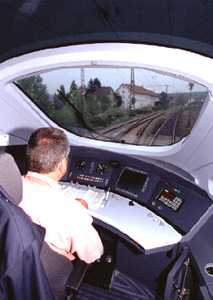 Driver's Cab (Photo Masatoki Minami) |
| ICE-T has 1st class and 2nd class. In the 1st class, seats are aranged
in 2+1 row, and in 2nd class in 2+2 rows. The interior can be changed from
1st class to 2nd class, and from 2nd class to 1st class. Behind the driver's
cab is the observation deck. They are divided by glass board, so passengers
can enjoy the same sight of the scenery from the front. The glass board
normally transparency, but it can chang to be translucent electrically.
In the 2nd class, the interior is only open plan, but 1st class has some
simple compartments. And a family room is equipped for each trainset. This
room has a space for children playing, a big table, a space for baby car,
and so on. And each set has some equipment for the handicapped. In each seat, there are some equipment by which passengers can use a personal computer, and enjoy audio programs. And some cars are called "Repeater". In these cars, people can use their own portable telephone more clearly. Lockers and spaces for bicycles and skis are equipped for sightseers. |
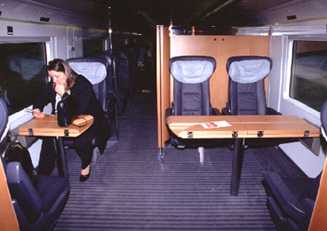 1st class (Photo) Masatoki Minami |
 Information Board (Photo) Akira Inoue |
| Class 411 has "BordRestaurant" and class 415 has "BordBistro". "BordRestaurant" is almost same as that of ICE-2. Restaurant has 24 seats, and the snack bar has some tables. "BordBistro" has only some table and passengers can receive self-service. In rthe service room, passengers can many kinds of information and buy telephone cards. The FIS system have been improved and passengers can print the timetable. |
![]()
| Train Composition of Class 411 |
| 411.5 (21) |
411.6 (22) |
411.7 (23) |
411.8 (24) |
411.2 (25) |
411.1 (27) |
411.0 (28) |
![]()
| Class | Trailar / Motor car | Equipment |
| 411.5 | Trailar | 2nd class, "Repeater" |
| 411.6 | Motor with Invertor | 2nd class, Equipment for the hadicapped, FIS terminal |
| 411.7 | Motor | 2nd class, "Repeater", Service room |
| 411.8 | Trailar | 2nd class |
| 411.2 | Motor | "BordRestaurant", Family room |
| 411.1 | Motor with Invertor | 1st/2nd class, FIS terminal |
| 411.0 | Trailar | 1st class, "Repeater" |
| An unit of class 411 consists of 7cars and has a seating capacity of 360 (1st: 53, 2nd: 307), and the length is 184.4m, power output 4,000kW. Some trainsets have no 411.8, and are operated as 6-car-sets. And some have two 411.8, operated as 8-car-sets. |
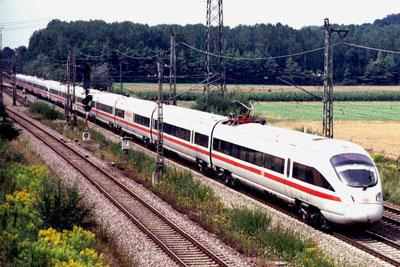 Class 411 between München Pasing and Haspelmoor (Photo) Yutaka Okamoto |
![]()
| Train Composition of Class 415 |
| 415.5 (21) |
415.6 (22) |
415.7 (23) |
415.1 (27) |
415.0 (28) |
![]()
| Class | Trailar / Motor car | Equipment |
| 411.5 | Trailar | 2nd class, "Repeater", Space for bicycles |
| 415.6 | Motor with Invertor | 2nd class, Equipment for the hadicapped, FIS terminal |
| 415.7 | Motor | 2nd class, "Repeater", Service Compartment |
| 415.1 | Motor with Invertor | "BordBistro", 2nd class, Family compartment, FIS terminal |
| 415.0 | Trailar | 1st class, "Repeater" |
| An unit of class 415 consists of 5 cars and has a seating capacity of 253 (1st: 41, 2nd: 212), and the length is 132.6m, power output 3,000kW. 11 units of class 415 can connect to Switzerland. These units has a second pantographs in each end cars (415.0, 415,5). |
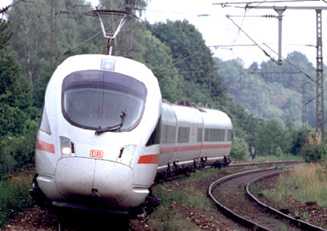 Class 415 near Singen (Photo) Masatoki Minami |
![]()
| The Operation of ICE-T |
| In May 30, 1999, ICE-T entered in service. 5 sets of class 415 which could be connect to Switzerland were operated for Stuttgart - Singen - Schaffhausen - Zürich in about every two hours. (Cisalpino was operated in this line, too.) The figure below shows all trains which were st first operated by ICE-T. |
| ICE 180 "Paul Klee" | Zürich Hbf 1910 --> 2155 Stuttgart Hbf (via Winterthur) |
| ICE 181 "Friedrich Hölderlin" | Stuttgart Hbf 0602 --> 0748 Singen (Htw) |
| ICE 182 "Friedrich Hölderlin" | Singen (Htw) 1810 --> 2000 Stuttgart Hbf |
| ICE 183 "Paul Klee" | Stuttgart Hbf 0802 --> 1050 Zürich Hbf (via Winterthur) |
| ICE 184 "Rudolf Steiner" | Zürich Hbf 1310 --> 1600 Stuttgart Hbf (via Winterthur) |
| ICE 185 "Rudolf Steiner" | Stuttgart Hbf 1202 --> 1450 Zürich Hbf (via Winterthur) |
| ICE 186 "Isolde Kurz" | Singen (Htw) 1010 --> 1200 Stuttgart Hbf |
| ICE 187 "Isolde Kurz" | Stuttgart Hbf 1402 --> 1547 Singen (Htw) |
| ICE 188 "Hermann Hesse" | Zürich Hbf 0713 --> 1000 Stuttgart Hbf (via Buelach) |
| ICE 189 "Hermann Hesse" | Stuttgart Hbf 1802 --> 2047 Zürich Hbf (via Buelach) |
| ICE NETWORK |
| From fall 1999, more and more routes started to be operated by ICE-T. Class 411 was already enter its service.At first some InterCity or InterRegio trains were operated by ICE-T, but recently ICE-T is used for ICE. From May 2000, two lines are operated by ICE-T. The line Berlin - Leipzig - München is operated by class 411, and Dresden - Leipzig - Frankfurt is operated by double sets of class 411 or class 411 + 415. Some of EXE trains - special trains for Hannover Expo2000 - are also operated by ICE-T. Sometimes two trainsets of ICE-T are coupled each other. |
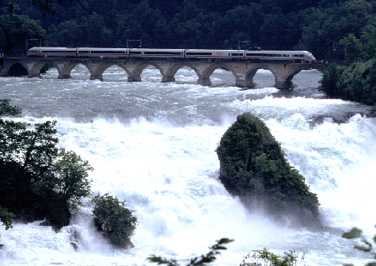 Class 415 in Schaffhausen (Photo) Masatoki Minami |
![]()
| DBAG Official Site |
| The ICE/ICT pages by Tobias Köler |
| Eisenbahn-Review 6/1999 |
| BAHN EXTRA "Bahn-Jahrbuch '99" by GeraNova |
| Railway Fan, Railway Journal (Railway magazines published in Japan) |
![]()
| Written by Hisa HUH and Akira Inoue (faminoue@aay.mtci.ne.jp) Special thanks to Masatoki Minami, a photographer. (His homepage) |
![]()
| Back |